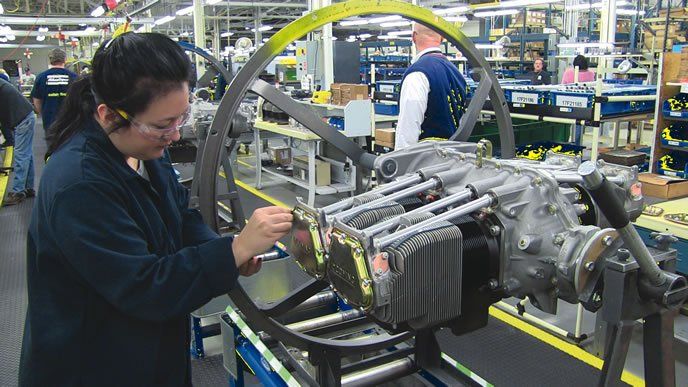To survive in a market thats a shadow of what it was 40 years ago, Lycoming and Continental have had to reinvent themselves. This is the first of a series explaining changes at the engine companies.
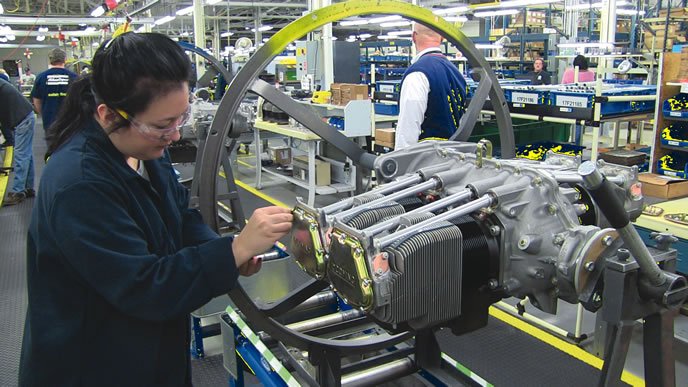
Whens the last time your late-model car broke? Not a check-engine light, but we’ll and truly quit? It probably hasnt happened and one reason for that is that modern automotive quality is relentlessly driven by quality control systems that favor high volume in factories that build the very same engine, or transmission or ignition module in which the only thing that changes in 50,000 units are the serial numbers.
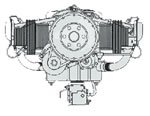


At the opposite end that continuum is Lycoming, a company that holds more than 700 engine type certificates, each with different designations, different model numbers, unique accessories and sometimes discrete core components for the same families of engines. A Toyota process engineer used to making 300,000 Camry engines a year would need a fistful of Valium to survive the shock of touring the assembly line in Williamsport.
Yet…Lycoming has confronted the seemingly insurmountable challenge of so-called high-mix, low-volume manufacturing with a careful, if modest, program of re-investment in a factory whose origins date to the 19th century. Even as the market it depends on flattens or shrinks, the factory has reduced its physical footprint and become measurably more efficient. Twenty years ago, it was outsourcing raw manufacturing at such a rapid clip that it seemed it would evolve into an assembly business with a specialty in drop shipping parts.
Didnt happen. Today, thanks to rapid advances in flexible, computer numerical machine tools and a determination to adapt high-volume quality control methods to trickle volume, Lycoming is bringing vendor work back inhouse.
Now, Lycoming produces many parts that it used to outsource at prices competitive with vendors and at what it says is potentially higher quality. This could be an MBA case study in turnaround management, but its more accurate to describe it as a survival story in an industry worn down by declining markets and escalating costs. Last fall, I spent nearly three days touring and filming the plant for this report and an accompanying video. Heres what I learned.
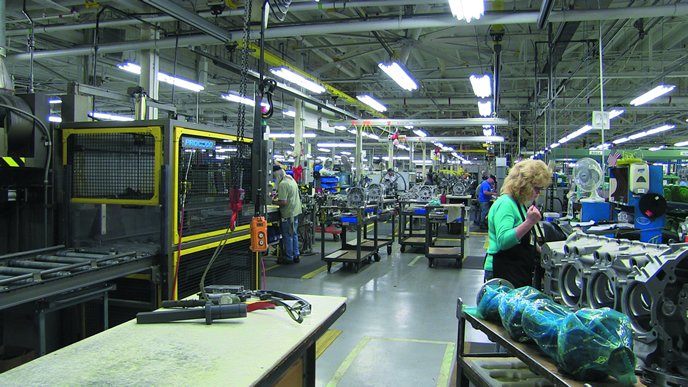


Black Spiral
Modernization and reinvestment is a routine part of the manufacturing landscape. Machines wear out, new ones do a better, faster job and planned capital improvement is a fact of business life. But this gets sticky in industries where there is little or no growth and no prospects for reversing that, no matter how much you spend on new equipment. The promise of efficiency wrought by new machinery is alluring, but you still have to spend the money.
In aviation, there’s an understandable tendency to limp along with old equipment, repairing and refurbing and making do, sometimes with machines that are 70 years old.
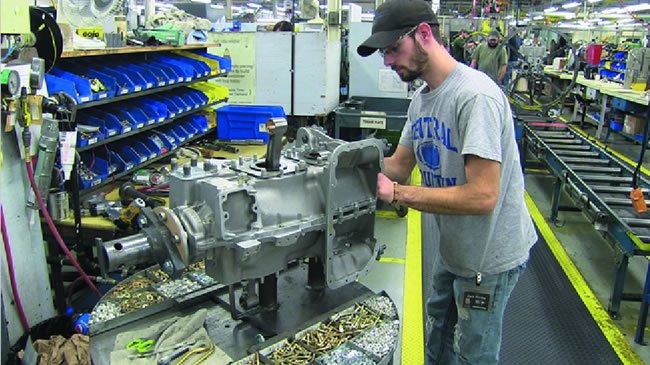


But competition and technology don’t stand still. New machinery, despite its cost, can be markedly more efficient and, more important, flexible in setup, capability and automated operation, the trifecta of modern small-lot manufacturing. An established mainstay in a sunset industry that has to live with aggressive competition-and Lycoming does-can find its internal costs too high to compete. And Lycoming did.
You cant be caught in an environment where it costs you more to put stuff out the door than the price you can get for it, says Michael Kraft, Lycomings general manager. During the early 1990s, when Lycoming was tilting strongly horizontal, that strategy made sense because there was surplus manufacturing capacity capable of building parts cheaper than Lycoming itself could.


The Tide Turns
That strategy raises quality control challenges, but it still made no sense for Lycoming to build that capability in-house, or so the thinking went then. So it shrunk. Every time we visited the plant, another bank of machine tools had been mothballed or retired and the floorspace reduced.
And then you have reduced volume. But you cant shrink yourself to prosperity. You have to invest internally or youre going out of business, Kraft says, adding that Lycoming faced a black spiral of higher materials costs and high production costs that competitors-mainly PMA houses-were able to capitalize on, squeezing profits by building high-volume parts, but not stuck with providing the small-volume stuff that customers expect to keep their aircraft flying.
With no pricing power to raise margins against competitors and no meaningful ability to reduce production costs, Lycoming had nowhere to go. We were caught in a trap. The costs of raw materials hasnt gone down. Just to compensate for that, we have to drive production costs down, Kraft says.
What changed in Lycomings favor is a technological evolution in computing power coupled to numerical machining equipment. The tools became more affordable, more capable and more flexible.
Single machining centers-although they require skilled operators-can displace dozens of dedicated, hand-operated machines, enabling a trend back toward vertical integration.
Once its integrated into the manufacturing flow-which sounds easier than it is-modern CNC equipment turns out parts faster, with less set-up time (with fewer errors) and at higher rates of repeatability, the very hallmarks of the automotive-type quality aviation process engineers dream about but struggle to achieve. Kraft said the factory has engaged in target shooting to decide what parts it can produce competitively and what it cant. The size of these investments, as industrial capital improvements go , isn’t staggering. Lycomings automated piston line, for example, took several years to bring online and cost about $4 million. A recently completed nitriding cell was about $1 million and machining centers have tags on them in the $600,000 range. But when revenues are flat and profits are vaporously thin in aviation, managers may have to repeat to themselves that you have to spend money to make money. We didnt have a choice, Kraft says.
A New Landscape
In the 20-plus years Ive been touring Lycoming, the factory has undergone continuous but almost glacial change. But in those two decades, it has gone from a dank and dark old-school factory populated by ancient machinery to one that while not quite a paradigm of European modern, has nonetheless integrated state-of-the art technology at every turn. This became most obvious when Lycoming began what I heard called the investment around 2007, ahead of the 2008 downturn when the aviation economy at least showed a pulse.



Some of the major investments include new crankshaft machining cells, a large flexible cell called a Space Center made by the Japanese machine tool giant OKUMA and a custom-made piston line that does everything but turn raw bauxite into finished parts. Less noticeable are the quality systems integrated with this equipment, made possible by machines that faithfully follow well-tested machining programs and record their every mill, broach and bore for the statistical process control that forms the bedrock of modern manufacturing quality.



During my tour of the plant, Lycoming production manager John Hartsock explained how the Space Center has been configured to machine accessory cases, the back end of a Lycoming engine thats a complex machining problem because its heavily populated with pads, bosses, holes and threaded fittings. Lycoming engines have a variety of accessory cases, each with its own dimensions and hole patterns. Before the advent of flexible CNC, such a part would visit a dozen individual manual work stations, each an opportunity for a set-up error or a mis-machining by an undetected worn tool.
Now, the Space Center and machines like it can process the entire part in a series of unsupervised operations, changing its own tools and compensating for a worn cutting edge. Moreover, says Kraft, advances in such mundane things as cutting fluids and tools have increased production efficiency measurably.



Flexible CNC can-and does-economically accommodate short runs. That plays out for the customer with direct results: Seldom-ordered parts that used to take months to deliver until the factory accumulated enough orders to make building them economical can now deliver on shorter turn times. Its a better part, we make it faster and there are fewer errors, Hartsock told me. He walked me past a production cart loaded with a half dozen accessory cases with splotches of red paint; an entire years worth of rejects.
Not that long ago, that might have been a months worth. And although Lycoming has had statistical process control in place for years, it has more of it now than ever, all tied into CNC tooling that does more than it ever did. And not that long ago, bad parts slipped through QC to the customer. Thats far less likely to happen now, Hartsock said. At every turn, small but constant improvement-the Japanese kaizen process that U.S. industry has universally adopted-are evident. In a run of a dozen accessory cases, the first and last in the run are sent to the QC lab for careful inspection by a coordinate measuring machine, a process that requires the part to temperature stabilize for 24 hours.



During my visit, Lycoming had just installed a new CMM right next to the machining cell, one that compensates for temperature, eliminating the bottleneck. Its a minor efficiency, but in an industry where the low-hanging fruit has long since been picked, little things add up in the drive toward manufacturing consistency.
When we toured the CMM lab, I asked Lycomings Mike Everhart, Lycomings VP of products and services, what long-term effect the integration of CNC and quality systems has had on the plants CpK trend. CpK is an index of how close a production process is actually running relative to its intended specs; the more consistent they are around the desired specs, such as dimensions and materials, the better. Our CpKs used to look like this, said Everhart, tracing a zigzag with his finger, now theyre like this, he added, drawing a flatline with his other palm.
What Customers Say
In keeping with the kaizen philosophy, improvements at Lycoming have been steady. The drama derives from looking at the changes over two decades. Are customers noticing? Frankly, its difficult to determine this. I checked with several engine shops and distributors and got a generally positive if mixed reaction. The industry has become so small that some companies are simply fearful of saying anything-positive or negative-that might offend their suppliers. One major distributor of Lycoming parts declined to return calls and an engine shop we normally count on for reality checks wouldnt discuss Lycoming at all.
But those that did speak to us suggest that Lycoming quality was, with only a few significant exceptions, never bad to begin with and hasnt noticeably changed, either in the quality of the parts themselves or the speed and accuracy of order fulfillment. Shops do complain about pricing. Where Lycoming has competition, prices are competitive. Where it does not, expect sticker shock. At Certified Engines in Opa-Locka, Florida, Allen Weiss told me cylinders for the TIO-540-AJ1A used in the Cessna 206, which only Lycoming makes, cost about $2800, compared to $1100 to $1300 on cylinders where there’s PMA competition. And hows the quality? Ive had a couple of small issues, but I think its jam up. Theyre good, Weiss said. He said the supply chain usually has parts on the shelf. As for engines from the factory, Weiss says the introduction of roller tappets has noticeably reduced the incidence of cam and lifter spalling.
I havent heard of any fubars on the part of Lycoming. We might have an occasional engine burning too much oil, but I don’t think thats the factorys fault, says Charlie Mellot of Zephyr Engines. As far as order filling and accuracy, Mellot says the shop orders through Air Power, but factory direct orders are not better or worse than they ever were.
The low point for Lycoming quality was undoubtedly the massive recall of 1500 crankshafts in 2003, a multi-million-dollar effort that also embroiled the company in litigation. Perusing recent Lycoming ADs, there arent any nearly as significant as that. The companys Michael Kraft told us another crankshaft catastrophe is less likely to happen now. Weve actually extended Lycoming process control right down to the melting of the crankshaft metal. You have to look three levels down the supply chain. Thats where you have to go now, says Kraft, describing an industry-wide trend.
Lycomings Future
Both Lycoming and Continental have made significant investments in modern machine tools. While Continental has been the beneficiary of generous Chinese capital through its AVIC International parent, Lycoming has internally financed its own transformation, both as a means of simple survival and to fund modest future development, with an emphasis on modest.
Kraft has heard the slur Lycosaurus so often that he takes grim humor in referencing it. Ten or 15 years ago, you basically had a business that was not efficient enough to put capital investment and R&D into the business. Therefore, you had Lycosaurus…wheres the new product? Kraft says.
You dig out of that hole by investing first in manufacturing processes. Heres the hindsight thinking. We invested first in manufacturing technology to be able to get the headroom for R&D because you cant count on the return from the new products. We know its going to be a long time before the IE2 or the DEL 120 investment pays off, he adds.
Indeed, the expensively developed IE2 FADEC-controlled engine still isn’t certified and has only minor OEM commitments in Lancair, Tecnam and Northrop Grummans Firebird, a pilot-optional aircraft just coming online. Those arent large-volume customers. In fact, there may not ever be large-volume customers. And even though the UAV market is hot, the airframe numbers are low-the multiple dozens, not the hundreds, thus the DEL 120 diesel is some distance from profitable volume. Continental is in the same market straits with its diesels.
Lycomings strategy will likely remain targeted investments in sharply contained segments of its manufacturing, where it can push costs down and margins up. Take camshafts, for example, which are now bought from vendors. Were going to have to figure out if we can do solidly better on camshafts for a decade than our supply base can. Can we do it better and more cost competitively than the supply base can? Kraft asks.
Increasingly, the answer to that may be yes. But don’t expect any swing-for-the-fences, cutting-edge engine developments, which can cost $40 to $60 million to develop. Like it our not, thats the reality Lycoming faces.

